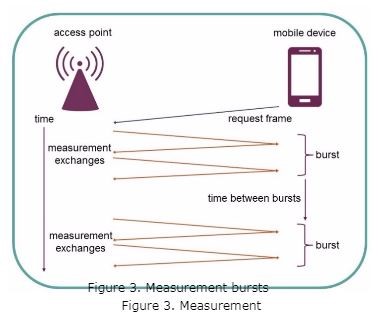Wi-Fi is currently installed in 8 billion devices and is expected to reach 12 billion devices by the year 2020. It carries more than half of the internet’s traffic, with some estimating it as high as 70%. Wi-Fi is everywhere, in part because it offers extensive reach. But where is it going from here? It's adding location technology.
Existing location techniques that involve Wi-Fi technologies utilize RSSI, which lacks accuracy, and RSSI fingerprinting, which is more accurate but expensive and hard to maintain. Other location techniques rely on proprietary methods. The problem with this is that beacons may have limited range and need to cover large spaces.
Enter Wi-Fi Location, which can determine the distance between two Wi-Fi devices by measuring the time it takes for a wireless signal to be exchanged between them. It measures time of departure and time of arrival to the nanosecond, and it uses clock synchronization, round-trip measurement, and location-coordinate systems.
Creators say that it is highly secure and extremely accurate, enabling turn-by-turn wayfinding indoors. This is important because it can supplement GPS in areas where the signal is not strong, like indoor locations or cities in which there are tall buildings. Whereas GPS typically provides precision within three to 10 meters outdoors, Wi-Fi Location can get you within 90 centimeters — within arm’s length of a particular point or object.
This sort of accuracy gives way to a number of previously unheard-of applications for Wi-Fi Location, promising big things for the future. Wi-Fi Location allows for turn-by-turn wayfinding indoors, not only broadcasting latitude and longitude coordinates for exact location, but also civil location — like 123 Fake Street, Eighth Floor — which could be a game changer for rescue services.
It can also track mobile assets quickly and accurately, which might be useful if you’re prone to losing the remote or want to have eyes on some sort of inventory. You’ll also be able to improve the maintenance of a network by pinpointing exact locations where problems occur.
 Image Source: Wi-Fi Alliance.
Image Source: Wi-Fi Alliance.
Wi-Fi Location may also be used to create a geofence, or virtual perimeter, that triggers a specific action. This may be useful across a number of industries, but it is particularly impactful for areas in which something is coming or going with some frequency, like a garage or even a car dealership.
Perhaps one of the biggest uses of this technology will be for retailers, who can learn behavior patterns and change shopping experiences based on their findings. Imagine coupons that could guide you to the physical location in the store or alert you when you pass an item you might like that’s offering a discount.
A phone can determine its location with or without sharing that information with others, so there is no concern for privacy — you can use Wi-Fi Location to navigate but must allow special permission if you would like it to track.
The Wi-Fi Alliance envisions the technology as also being useful in the creation of smarter cities, bridging the gap between indoor and outdoor environments. But to realize its full potential, Wi-Fi Location must offer the same degree of multi-vendor interoperability as Wi-Fi data networking. To ensure that happens, the Wi-Fi Alliance has launched a Wi-Fi Certified Location program to test and certify location-enabled Wi-Fi products as they begin entering the market later this year.
Wi-Fi Location will become automatically available with newer Wi-Fi installations without the need for additional hardware, so eventually, it will be ubiquitous. Developers can and should begin planning uses now with the assumption that it will be available, much like Bluetooth. However, most devices on the market today do not have location capabilities, which means that there will be a transition time as people upgrade their devices.
“Wi-Fi is ubiquitous in smartphones and in network deployments around the world, giving it unparalleled reach for indoor location-based applications,” said Samuel McLaughlin, research analyst, ABI Research. “Wi-Fi Location accuracy opens new opportunities for consumer and business applications, filling a gap left by the unavailability of GPS indoors.”
Advertisement
Learn more about Electronic Products Magazine





